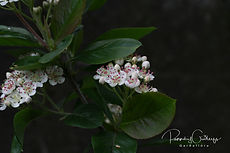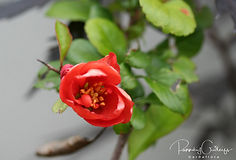

Flowering
Trees and Shrubs
Deciduous trees and shrubs with ornamental flowers

Aesculus - Horse chestnut, Buckeye
Aesculus is a genus in the family Sapindaceae with around 20 species native to N-America and Eurasia. One of the characteristics of the genus are the palmately divided leaves and white or pink flowers in large pyramid shaped flower spikes. Their seeds are called conkers. The species of the genus are toxic.

Amelanchier - Serviceberry
Amelanchier is a small genus of around 20 species in the rose family, Rosaceae, distributed around temperate regions in N-America, Europe and Asia, with the greatest diversity in N-America. They are trees or shrubs with clusters of white flowers, some species bear edible berries.

Berberis - Barberry
Berberis is a large genus of close to 200 species in the family Berberidaceae, distributed around temperate and warm temperate regions of the world. Most species grow in S-America, Africa and Asia. They are either deciduous or evergreen, thorny shrubs with small yellow or orange flowers.
-
Berberis x bidentata (B. lologensis)
-
'Mystery Fire'
-
-
Berberis x ottawensis
-
'Silver Miles'
-
-
-
'Green Carpet'
-

Berberis - Barberry
Berberis is a large genus of close to 200 species in the family Berberidaceae, distributed around temperate and warm temperate regions of the world. Most species grow in S-America, Africa and Asia. They are either deciduous or evergreen, thorny shrubs with small yellow or orange flowers.
-
Berberis x bidentata (B. lologensis)
-
'Mystery Fire'
-
-
Berberis x ottawensis
-
'Silver Miles'
-
-
-
'Green Carpet'
-

Chaenomeles - Flowering quince
Chaenomeles is a genus in the rose family, Rosaceae, that only includes three species, all native to E-Asia. They are showy, spring flowering shrubs that all flower orange or red flowers before leafing out
-
Chaenomeles japonica
-
Chaenomeles x superba
-
'Crimson and Gold'
-

Chiliotrichum
Chiliotrichum is a small genus of four species in the aster family, Asteraceae, which are all native to the southern part of S-America, Argentina and Chile. They are shrubs with narrow, greyish leaves and white, daisy-like flowers.
-
Chiliotrichum diffusum

Cornus - Dogwoods
Cornus is a genus of around 30-60 species in the family Cornaceae distributed around northern temperate regions. The species that can be grown here have clusters of small, white flowers, but many species that grow in warmer climates have large, showy flowers that play a big role in the spring time flower extravaganza.
-
Cornus alba - mjallarhyrnir
-
Cornus sanguinea - dreyrahyrnir
-
'Winter Beauty'
-

Cotoneaster
Cotoneaster is a genus in the rose family, Rosaceae , distributed around temperate regions of Eurasia and N-Africa. The number of species varies between 70-300, depending on how species are defined. Mountains in SW-China and the Himalayas have the greatest number of species. Most are shrubs, procumbent species grow at high altitudes and taller species closer to sea level.
-
Cotoneaster adpressus
-
Cotoneaster congestus
-
Cotoneaster lucidus
-
Cotoneaster x suecicus
-
'Skogholm'
-
-
Cotoneaster purpureus
-
'Variegatus'
-
Crataegus - Hawthorns
Crataegus is a large genus in the rose family, Rosaceae, with close to 200 species distributed around temperate regions in Eurasia and N-America, where the greatest species diversity is. They are trees or shrubs, often with thorns, that have clusters of white or pink flowers and berries that are an important food source for wildlife in their native habitats.
-
Crataegus douglasii
-
Crataegus laevigata
-
'Paul's Scarlet'
-


Cytisus - Brooms
Cytisus is a genus of around 50 species in the pea family, Fabaceae. They are native to scrublands or heaths in Europe, N-America and western Asia. These are shrubs, with dense, upright, green branches, small thread-like leaves and yellow, red or pink flowers that smother the shrubs while they are in flower.

Daphne
Daphne is a genus in the Thymelaeaceae family. The genus is native to regions in Asia, Europe and N-Africa. They are deciduous or evergreen shrubs, many procumbent. Many flower in late winter or early spring. The flowers are small, greenish, white or pink. The berries are very toxic.
-
Daphne alpina
-
-
f. alba
-

Deutzia
Deutzia is a genus of around 50 species in the Hydrageaceae family. Their main distribution area is in China, but a few species are native to Central-America, Europe and Central- and East-Asia. They are shrubs with clusters of white or pink flowers.
-
Deutzia x hybrida
-
Deutzia scabra
-
'Plena'
-

Forsythia
Forsythia is a genus of 11 species in the family Oleaceae, which are all native to Asia, except one which is native to SE-Europe. All species flower in spring, before leafing out, yellow flowers.
-
Forsythia ovata

Holodiscus
Holodiscus is a genus in the rose family, Rosaceae., that includes 10 species, all of which are native to N- and S-America. They are shrubs that flower long, drooping clusters of tiny, white flowers.

Laburnum - Golden rain
Laburnum is a genus in the pea family, Fabaceae. The genus includes only two species, both native to mountains in S-Europe. They are small trees with trifoliate leaves and long, hanging clusters of yellow flowers. They are highly toxic.
-
Laburnum alpinum
-
Laburnum x watereri
-
'Vossii'
-

Lonicera - Honeysuckle
Lonicera is a large genus in the famly Caprifoliaceae. Around 180 species belong to the genus, with a wide distribution around the northern hemisphere, the majority in China. The majority are climbers, but most species grown in Iceland are shrubs. The flowers can be white, yellow, pink or red, usually borne in pairs.
-
Lonicera caerulea
-
-
var. xerocalyx
-
-
Lonicera involucrata
-
'Kera'
-
-
Lonicera pileata
-
Lonicera spinosa

Malus - Apples
Malus is a genus of 30-50 species in the rose family, Rosaceae, with a wide distribution around temperate regions in the northern hemisphere. The apple, Malus pumila, which is an important food crop belongs to the genus, other species are grown as ornamental plants. Apple species need at least two plants in close proximity for the fruit to ripen.
-
Malus purpurea
-
Malus sargenti

Philadelphus - Mock-orange
Philadelphus is a genus in the Hydrangeaceae family, with around 60 species of shrubs, native to N- and Central-America, Asia and SE-Europe. The flowers are white and usually very fragrant.
-
Philadelphus caucasicus
-
'Aureus'
-
-
-
'Þórunn Hyrna'
-
-
Philadelphus lewisii
-
'Tähtisilmä'
-
-
Philadelphus x virginalis
-
'Minnesota Snowflake'
-

Physocarpus - Ninebark
Physocarpus is a genus of around 6-20 species in the rose family, Rosaceae. Their main distribution area is N-America, with one species in NE-Asia. They are deciduous shrubs with palmate leaves and clusters of small, white or pink flowers.

Potentilla - Cinquefoils
The genus Potentilla belongs to the rose family, Rosaceae, and includes over 300 species, most of which are herbaceous plants. A few are shrubs and one of them, P. fruticosa, is a popular garden plant here in Iceland.
-
Potentilla fruticosa

Prunus
Prunus is a genus in the rose family, Rosaceae, and includes around 430 species with a wide distribution around the northern hemisphere. Many popular fruit trees belong to the genus, cherries, plums, peaches, apricots and almonds. They are small trees that often flower before leafing out, white or pink flowers.
-
Prunus nipponica var. kurilensis
-
Prunus padus
-
Prunus virginiana

Ribes - Currants
Ribes is a genus in the family Grossulariaceae, native to temperate regions in the northern hemisphere. Edible currants belong to the genus, but many species are also grown as ornamental shrubs.
-
Ribes alpinum
-
'Lára'
-

Sambucus - Elderberries
The genus Sambucus has a wide distribution around temperate and warm temperate regions. The genus was recently moved to the family Adoxaceae. Raw elderberries are toxic, but both flowers and cooked berries are used as culinary ingredients.
-
Sambucus racemosa

Sorbaria
Sorbaria is a genus of 9 species in the rose family, Rosaceae, most of which are native to E-Asia. The leaves resemble plants in the genus Sorbus. They bear clusters of small, white flowers.

Sorbus
Sorbus is a large genus of around 100-200 species in the rose family, Rosaceae, widely distributed around the northern hemisphere. Some botanists believe the genus should be divided into four genera based on the shape of the leaves and fruit. Species with compound leaves (Rowan/Mountain Ash) would remain in the Sorbus genus, whereas species with simple leaves would be moved to the genus Aria (Whitebeam). That division is not followed here.
-
Sorbus aria
-
'Lutescens'
-
-
Sorbus americana
-
Sorbus bisettii
-
-
'Dodong'
-
-
Sorbus mougeotii
-
Sorbus rosea
-
Sorbus vilmorinii

Spiraea - Spirea
Spiraea is a genus of around 80-100 species of shrubs in the rose family, Rosaceae, native to northern temperate regions. Most species diversity is in E-Asia. They flower white or pink flowers in clusters or spikes.
-
Spiraea arcuata
-
-
ssp. aemiliana
-
-
Spiraea x cinerea
-
'Greifsheim'
-
-
-
'Golden Princess'
-
'Little Princess'
-
Spiraea nipponica
-
Spiraea sargentiana
-
Spiraea sp.
-
Spiraea trilobata

Symphoricarpos - Snowberry
Symphoricarpos is a small genus of around 15 species in the Caprifoliaceae family. Their main distribution area is in N- and Central-America, but one species is native to China. The berries are the main ornamental feature of the plant, they can be white, pink or red and can last on the shrub well into winter. The flowers are small, greenish white or pink.
-
Symphoricarpos albus
-
'Svanhvít'
-
-
Symphoricarpos x doorenbosii
-
'Marleen'
-

Syringa - Lilacs
Syringa is a small genus of around 12 species in the family Oleaceae, native to shrublands and woodlands from SE-Europe to E-Asia. They are small trees or shrubs with large panicles of small, white, pink, lilac or purple, often fragrant, flowers.
-
Syringa x prestoniae
-
'Royalty'
-
Syringa x henryi
-
Syringa josikaea
-
'Holger'
-
-
Syringa reflexa
-
Syringa sp. 'Bríet'
-
Syringa tomentella
-
Syringa yunnanensis
-
Syringa wolfii
-
'Valkyrja'
-

Viburnum
Viburnum is a genus of around 150-175 species native to temperate regions in the northern hemisphere. It was formerly classified in the Caprifoliaceae family, but has now been moved to the family Adoxaceae. The flowers are small, white or pink, borne in clusters. In some species the flower cluster is surrounded by larger, infertile flowers that serve the purpose of attracting insects.
-
Viburnum carlesii
-
'Aurora'
-
-
Viburnum edule
-
'Funi'
-
-
Viburnum lantana

Weigela
Weigela is a genus in the Caprifoliaceae family All species of the genus are native to E-Asia. The flowers are trumpet shaped in small clusters, white, yellow, pink or red.
-
Weigela florida
-
'Bristol Snowflake'
-
-
Weigela middendorfiana
